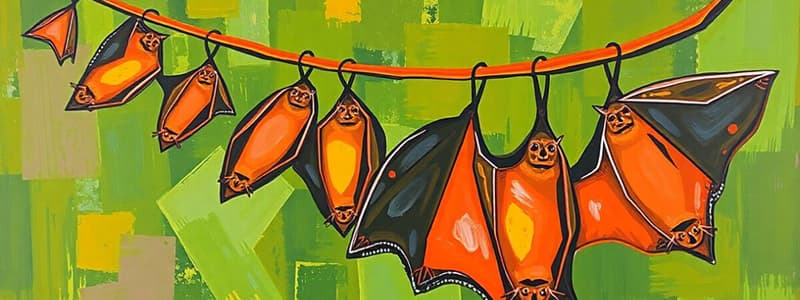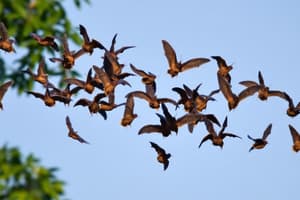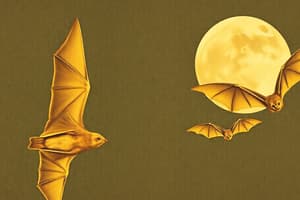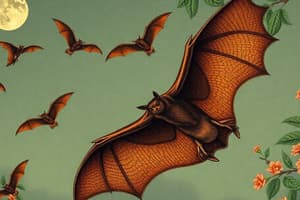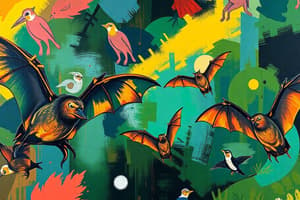Podcast
Questions and Answers
What distinguishes straw-colored fruit bats' seed dispersal from that of other animals, enhancing their ecological role?
What distinguishes straw-colored fruit bats' seed dispersal from that of other animals, enhancing their ecological role?
- Their migration patterns are more predictable, ensuring seeds are deposited in optimal locations.
- They consume a wider variety of fruits, leading to a more diverse seed distribution.
- They have a higher seed germination rate due to their unique digestive enzymes.
- They disperse seeds outside the forest canopy, unlike many other animals. (correct)
Considering the ecological role of straw-colored fruit bats, what far-reaching consequence could result from a significant decline in their population?
Considering the ecological role of straw-colored fruit bats, what far-reaching consequence could result from a significant decline in their population?
- Alterations in soil composition because of reduced bat guano deposition.
- A surge in insect populations due to the reduction in bat predation.
- Disruption of seed dispersal, impacting both wildlife and human communities dependent on those plants. (correct)
- Increased competition among other frugivorous species, leading to population imbalances.
Given the threats of habitat loss and hunting faced by straw-colored fruit bats, what conservation strategy would most effectively address both challenges simultaneously?
Given the threats of habitat loss and hunting faced by straw-colored fruit bats, what conservation strategy would most effectively address both challenges simultaneously?
- Establishing protected wildlife corridors to connect fragmented habitats and implementing stricter hunting regulations. (correct)
- Implementing captive breeding programs to increase bat populations and lobbying for international bans on fruit exports from affected regions.
- Creating artificial roosting sites to compensate for habitat loss and promoting bat consumption as a sustainable food source.
- Relocating bat colonies to less disturbed areas and offering financial incentives for hunters to cease their activities.
How might the unique social behavior of straw-colored fruit bats, forming colonies in the millions affect their vulnerability to environmental changes and human activities?
How might the unique social behavior of straw-colored fruit bats, forming colonies in the millions affect their vulnerability to environmental changes and human activities?
Considering the ecological importance of straw-colored fruit bats in seed dispersal, which climate change impact would disproportionately threaten the ecosystems that depend on them?
Considering the ecological importance of straw-colored fruit bats in seed dispersal, which climate change impact would disproportionately threaten the ecosystems that depend on them?
What is the primary reason researchers are unsure why straw-colored fruit bats migrate to Kasanka National Park?
What is the primary reason researchers are unsure why straw-colored fruit bats migrate to Kasanka National Park?
Which challenge do scientists face when tracking the migration routes of straw-colored fruit bats?
Which challenge do scientists face when tracking the migration routes of straw-colored fruit bats?
If food is the main reason for the bats' migration, what unresolved question remains according to Dr. O'Mara?
If food is the main reason for the bats' migration, what unresolved question remains according to Dr. O'Mara?
What is the most accurate description of the straw-colored fruit bats' behavior during their stay in Kasanka National Park?
What is the most accurate description of the straw-colored fruit bats' behavior during their stay in Kasanka National Park?
What is the significance of the annual convergence of straw-colored fruit bats in Kasanka National Park?
What is the significance of the annual convergence of straw-colored fruit bats in Kasanka National Park?
What is a key uncertainty regarding the straw-colored fruit bats that migrate to Kasanka each year?
What is a key uncertainty regarding the straw-colored fruit bats that migrate to Kasanka each year?
What can be inferred from the fact that researchers haven't determined the exact reasons bats migrate to Kasanka?
What can be inferred from the fact that researchers haven't determined the exact reasons bats migrate to Kasanka?
How does the timing of the bats' migration to Kasanka relate to their mating habits?
How does the timing of the bats' migration to Kasanka relate to their mating habits?
Flashcards
Migration
Migration
Movement of animals from one place to another, often seasonal.
Seed Dispersal
Seed Dispersal
The act of dispersing seeds to new locations, aiding plant reproduction.
Habitat
Habitat
The natural home or environment of an animal, plant, or other organism.
Colony
Colony
Signup and view all the flashcards
Ecological Importance
Ecological Importance
Signup and view all the flashcards
Kasanka Bat Migration
Kasanka Bat Migration
Signup and view all the flashcards
Kasanka National Park
Kasanka National Park
Signup and view all the flashcards
Straw-Colored Fruit Bats
Straw-Colored Fruit Bats
Signup and view all the flashcards
Bat Migration Season
Bat Migration Season
Signup and view all the flashcards
Abundant Food Sources (Kasanka)
Abundant Food Sources (Kasanka)
Signup and view all the flashcards
Loquat Fruit
Loquat Fruit
Signup and view all the flashcards
Waterberry
Waterberry
Signup and view all the flashcards
Bat GPS Tracking
Bat GPS Tracking
Signup and view all the flashcards
Study Notes
- Millions of straw-colored fruit bats migrate to Zambia's Kasanka National Park annually, marking the world's largest mammal migration.
- The migration occurs from October to December, as bats from across Africa gather in the park's evergreen swamp forest.
- Bats spend nights feeding on wild fruits in surrounding farmlands and days resting in the forest.
- This cycle continues daily until January, when the bats disperse to habitats across the continent.
- Approximately 12 million fruit bats arrive each year, creating a massive, swirling cloud when they emerge from the trees.
- The reason for the bats' migration to Kasanka is still unknown, but it is not for breeding purposes.
- Bats mate in other African countries, such as Mozambique and Tanzania.
Possible Reasons
- Bats may be attracted to the area due to abundant food sources, such as loquats and waterberries.
- The bats only visit Kasanka for three months each year despite the year-round availability of fruit.
- The bats' migration routes and habits remain a mystery.
- Scientists use GPS tags to track the bats, but battery life is insufficient to last the entire year.
- It is unknown if the same bats return to Kasanka each year.
Ecological Importance
- The bats disperse fruit seeds across vast areas, maintaining the health and diversity of ecosystems.
- Other seed-dispersing animals are not as effective because the bats will leave the forest canopy.
- A colony of millions of bats dispersing one seed each per night has a huge impact.
About the Bats
- Straw-colored fruit bats are larger than most bat species, with a wingspan reaching up to 30 inches (76 cm).
- They are highly social animals, forming colonies in the millions.
- The species faces threats from habitat loss and hunting, with population decline impacting wildlife and human communities.
- Preserving habitats is crucial to protect this migration and the ecosystem it supports.
Studying That Suits You
Use AI to generate personalized quizzes and flashcards to suit your learning preferences.
